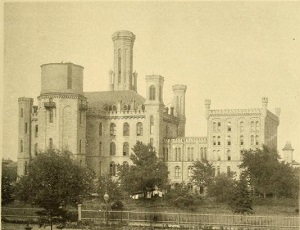Today, everybody may show up at a meeting within seconds of each other and every part of the world is in a time zone offset from English time by an exact number of hours (in some cases by 15, 30 or 45 minutes). It is difficult for us to realize that this system only started 132 years ago. It has been official in the U.S. for less than 100 years.
Chicago played a pivotal part, being the site of the 1883 General Time Convention. The Convention adopted "Standard Time" with four time zones, each offset by an exact number of hours from English standard time. This began a slow worldwide conversion to time zones based on the Greenwich meridian.
Prior to 1883, each city in the U.S. used its own time based on the local solar noon. This meant that when it when it was noon in Washington, D.C., it was 12:02 in nearby Baltimore, 12:07 in Philadelphia, 12:12 in New York, 11:17 in Chicago, etc.
The railroads themselves used 49 time zones. Often a city had not only its local time, but each railroad passing through the city used yet a different time—meaning that railroad stations needed multiple clocks.
Time Timeline
- Prehistoric times: several cultures developed means of measuring solar time, such as sundials. Water clocks allowed the measurement of intervals of time. However, time measurement continued to be based on the concepts of darkness, light and noon.
- Circa 1600: mechanical clocks were developed in Europe allowing somewhat accurate measurements of intervals of time. Time began, at least for scientists, to be thought of as constant, rather than varying with the seasons. Still, especially since there was no means or desire of transferring a time signal over any distance, every place observed local solar time.
- Circa 1800: accurate chronometers and advanced astronomy now allowed time to be transferred over a distance. This didn't affect ordinary people much, they still got up and went to bed with the sun.
- 1829: The time ball was invented. Bells and guns had long been used to transmit time. However, since sound takes 4.7 seconds to travel a mile, far-away observers would get inaccurate signals. A large ball dropped from a high place and visible throughout a city was the answer.
- 1847: Jeweler John H. Atkin appointed Chicago's first official timekeeper. According to Selling the True Time, a common arrangement at the time was to designate a jeweler as a city’s official timekeeper. The jeweler would display a clock in his window, which was periodically adjusted to solar noon by consulting sundials and astronomical tables. Within a few years, telegraph signals from remote astronomical observatories became an alternative to sundials.
- Circa 1850: a variety of technologies came together to promote both the desirability and means of uniform time. These included railroads, telegraphs and advances in clocks and astronomy. Mass production of watches and clocks allowed many more people access to time.
-
Circa 1870: Chicago, like a number of other cities, depended on a local observatory, its fire telegraph system and the courthouse bell to distribute time signals based on the local solar time to its citizens. Giles Brothers, jewelers, were the official timekeepers.
- November 19, 1883: Chicago adopted Central Standard Time (then called 90th Meridian Time) a day after the railroads. The rapid adoption of Standard Time by cities was somewhat of a surprise. Many thought cities would cling to their local time and only the railroads would find Standard Time useful. Jewelers looked forward to selling watches with two sets of hands, one for local time and one for railroad time.
- 1915: Detroit, the last major city holdout, officially adopted Eastern Standard Time. Detroit did have an excuse. Railroads always change time at a station stop, and railroad time split Detroit into two time zones.
- 1918: Congress made Standard Time official throughout the U.S. Minor changes in time zone boundaries continued to occur. Daylight Savings Time, the subject of the next post, also began.
For more information on the history of timekeeping, please consult the booklist.






Add a comment to: Standard Time: Technology That Changed Chicago